Note
I was wondering, in the crash test, for this, some one tried to argue it also looked like a seat belt failure. Are you please able to explain this abit further doe me. For example, the first frame you talk about the carseat is all the way forward, you mention this is because of how the belt path is? Can you explain abit more. Basically what I'm asking is the belt hasnt failed and even if the seatbelt was locked this would still occur? Thank you for your time. I really appreciate all the work do.
Apologises for the delay. This test has nothing to do with a seatbelt failure. The cables that can be seen are for the dummies many sensors. this was correctly fitted so it was entirely a child restraint failure due to substandard materials and design
0 notes
Note
Hi I have 2 boys aged 4 and 6. About 19 and 20kg. What are the best restraints for them. They have car seats they've had since little and they are good quality seats. They want to use seatbelt not harness but I'm not sure on weight etc.
At 4 and 6 they really should still be in a harnessed seat. Especially the 4 year old. It's not to do with fit rather how disclaimed they are in sitting back and not leaning forward. A child was killed last year as they were leaning forward when the car collided with traffic. Mynoick would be the Infasecure Odyssey or Genesis seats. I own both for my boys. The Odyssey can be turned into a seatbelt booster as well. The Genesis harnesses until at least 8 years of age
1 note
·
View note
Text
Just because its for sale doesn't mean its safe. An opinion on 3 in 1 Generic Car Seat Boosters
What you see above is the test video of a child restraint under the exact specifications as per the European ECE R44 standard its designed to meet. This testing was conducted by the highly respected Transport Research Laboratory. What can be seen here is the catastrophic failure of a child restraint at only 48km/h. Below is a version of this seat, commonly referred to as a 3 in 1 Generic booster. It is a forward facing child seat, which harnesses to 18kg and coverts to a seat belt booster after that. It can then have the back removed to be a half booster. These three stages lead to its name.
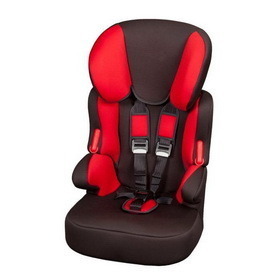
There is no doubt as parents and caregivers we want the safest seat we can afford to keep our children safe should a crash occur. There is this sense of “well if its for sale, it must be safe”, yet this child restraint is available for sale throughout New Zealand, as a generic frame, with which numerous manufacturers place different covers on. I will openly admit I was sucked in by this mantra and well known name attached to one of these seats when i turned my oldest boy FF. Something I quickly remedied when I became a restraint technician and began researching the topic. Whilst the seat is designed to meet the ECE R44 standard it can be seen in this test, failing that said standard.
The other issue with this type of seat is that they are difficult to install correctly, even for a qualified child restraint technician, let alone a parent or caregiver. This is due in part to the complex and convoluted path the vehicle seat belt must take. The standard does not require a upper tether and this results in the belt path it has to take. So lets take a look at the individual frames of this test to properly analyse the failure.

Frame 261 with the seat at the extent of the vehicle seat belt, and due to its poor design and belt path much further forward than it should be likely resulting in the child striking the seat in front or worse still being in the front seat of a vehicle and the airbag deploying directly into the child. Note the top black lead is actually the crash test dummy data cabling.
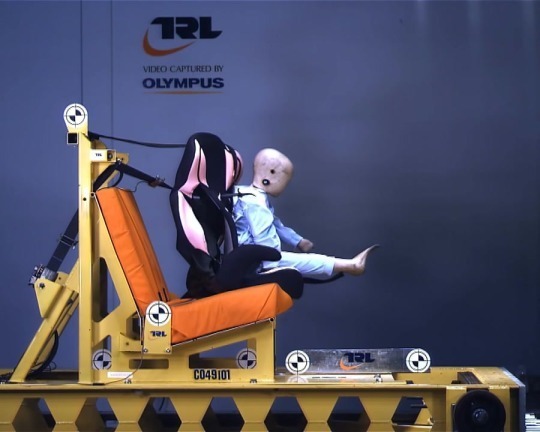
Frame 290. Due to the weak structural strength of the seat, belt path and loading the seat is now under as the dummy continues to move forward, the seat structure begins to catastrophically fail.
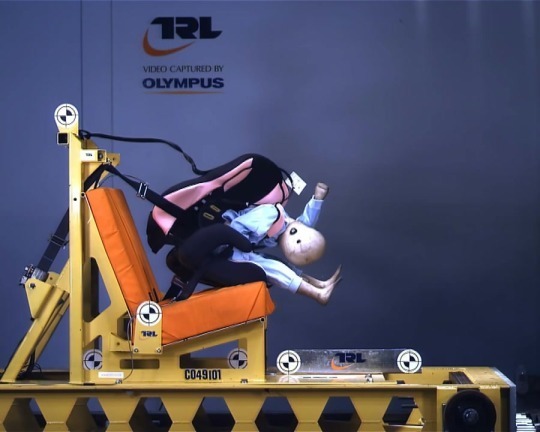
Frame 430. As the child continues to move forward the restraint’s structure further fails and the diagonal portion of the vehicle seat belt tears through the rear of the restraint as the lap portion of the belt ‘pulls’ on the bottom portion. This results in the restraint ‘folding’ around the child. The child certainly has struck the seat in front and likely to have suffered a broken collar bone and neck injury. All this from only a 50km/h impact.
So this is all good and well, so what about a real life example of this occurring in New Zealand? Below are photos of the result of an impact that occurred around 50km/h when a car pulled out in front of the driver of this vehicle. As is typically the case they had no little time to brake and avoid the collision. Whilst the driver received minor injuries and bruising the child in the seat in the left rear position (the other seat was empty) was left hanging upside down and with a broken collar bone, an injury that should not have occurred had the restraint done it jobs properly.
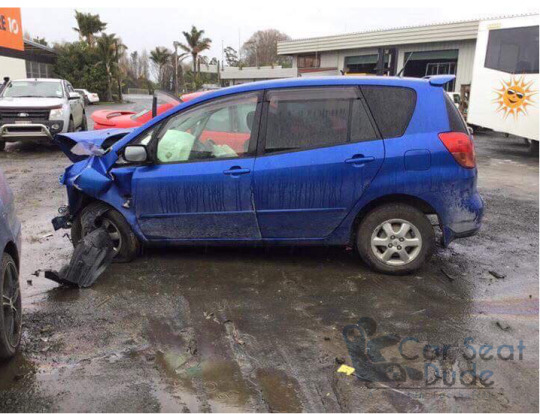
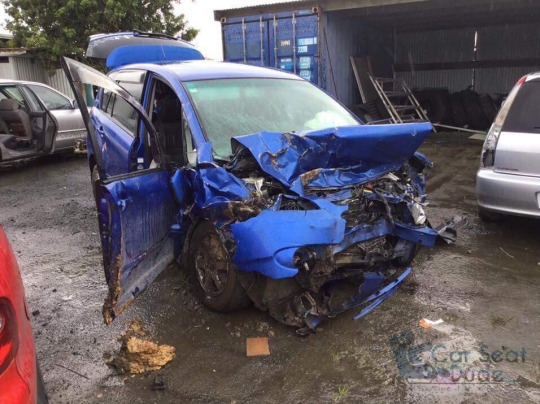

Note how the vehicle’s front has crumpled as its designed to do, to absorb the energy or force of the impact and increase the time over which the crash occurs. Reducing the forces felt by the occupants.
However you can see how the seats structure has catastrophically failed. Resulting in the injury to the child. A similar seat that was unoccupied sits beside it and has performed poorly by moving as a result of the collision forces.
Two things have occurred in this crash, one the seat is likely to have been installed incorrectly. Something that is all too common with these seats. In fact something that occurs around 76% of the time with all restraints in New Zealand. Secondly, what is shocking is that a seat should not fail this catastrophically when an install is incorrect, it should still hold the child in the harness. The vehicle seat belt in combination with the forces on the internal harness from the child has torn the seat apart.
The parent was not to know that the seat they purchased, were in this situation not up to the job. The belt path also made a good correct install more complicated than the majority of the child seats on the market.
Money is always a major factor in purchasing a child restraint, but the fact is there are good quality child seats not much more expensive than this, that offer far superior protection and are easier to install.
So what can I do you may ask….?. The majority of big retailers in NZ don’t have trained technicians, just sales people. So contact your local child restraint technician and discuss your options, they can then advise you on the best ‘bang for your buck’. They are a wealth of information and will give you options of seats that will offer your child the best protection within your budget. No matter where you purchase it from they will ensure its installed correctly and instruct you in installing it yourself. This is not a sale pitch for the expensive seats on the market, there is a seat that offers far better protection than the Euro Standard Generic 3 in 1 seats on the market. Both my children are in medium price range (Forward Facing) child restraints in the $300 range and I have the ability to purchase much more expensive seats. But I am confident they are in good safe seats that will last them harnessed until they are at least 7.5 for one seat and 8 for the other.
6 notes
·
View notes
Quote
Opinions don’t affect facts. But facts should affect opinions, and do, if you’re rational
Ricky Gervais
This is a quote that I always hang on the wall of the classroom when I am teaching Crash Analysis. A Crash Analyst must report on the evidence discovered at a scene and back it up with reference to peer reviewed and scientifically validated data. This is just as relevant when you look up information on the internet. Just because it is online does not make it correct or valid, as with any information it must be validated and from a reputable source. There is plenty of myths and misinformation in the area of child seat safety. So why am I different? In the 14+ years I have spent investigating motor vehicle crashes and now as a trainer of crash analysts I have attended and investigated near on 1000 crashes. I have given evidence in court as an expert witness on the subject of crash dynamics, physics, and mathematical analysis, all supported by my engineering background from service in the Airforce. I have seen the catastrophic effects that crash forces have on the human body and due to the share number of crashes, have become desensitised to it, however the death or serious injury of a child affects me deeply. I have seen what most don’t want to see, I have made those door knocks on family’s front doors late at night. For me I became a crash analyst to give families answers and to find what contributes to the death on our roads.
The serious injury of a 6 month old infant drew me into the world of becoming a Certified Child Restraint Technician and now I am a trainer and assessor of those who want to become or have trained as technicians. I Want to share my wealth of knowledge in crash investigation and child car seats to others, as education is the most powerful tool to reduce the unnecessary death and injury that occurs on our roads on a daily basis.
I will bring an evidence based practice approach to child safety in vehicles, in a way that anyone can understand. As Albert Einstein said “ If you can’t explain it simply, you don’t understand it well enough”
3 notes
·
View notes